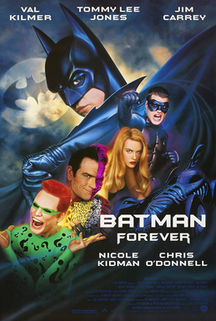
Batman Forever is a 1995 American superhero film directed by Joel Schumacher and produced by Tim Burton, based on the DC Comics character Batman. A stand-alone sequel to the 1992 film Batman Returns and the third installment of Warner Bros.'s initial Batman film series, it stars Val Kilmer replacing Michael Keaton as Bruce Wayne and Batman, alongside Tommy Lee Jones, Jim Carrey, Nicole Kidman, Chris O'Donnell, Michael Gough, and Pat Hingle. The plot focuses on Batman trying to stop Two-Face and the Riddler in their villainous scheme to extract confidential information from all the minds in Gotham City and use it to learn Batman's identity and bring the city under their control. In the process, he gains allegiance from a young, orphaned circus acrobat named Dick Grayson, who becomes his sidekick Robin, and meets and develops feelings for psychiatrist Dr. Chase Meridian, which brings him to the point to decide if he will lead a normal life or if he is destined to fight crime as Batman forever.

The Batcave is a subterranean location appearing in American comic books published by DC Comics. It is the headquarters of the superhero Batman, whose secret identity is Bruce Wayne, consisting of caves beneath his personal residence, Wayne Manor.

Alfred Thaddeus Crane Pennyworth is a fictional character appearing in American comic books published by DC Comics, most commonly in association with the superhero Batman.

James W. Gordon is a fictional character appearing in American comic books published by DC Comics, most commonly in association with the superhero Batman. The character debuted in the first panel of Detective Comics #27, Batman's first appearance, where he is referred to simply as Commissioner Gordon. The character was created by Bill Finger and Bob Kane. Commissioner Gordon made his debut as an ally of Batman, making him the first Batman supporting character ever to be introduced.
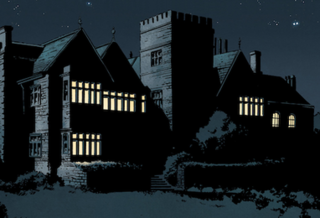
Wayne Manor is a fictional American mansion appearing in American comic books published by DC Comics. It is the personal residence of Bruce Wayne, who is also the superhero Batman.

Lucius Fox is a fictional character appearing in American comic books published by DC Comics, commonly in association with the superhero Batman. As a supporting character in the comics, he acts as Bruce Wayne's business manager at Wayne Enterprises who runs the business interests that supply Batman's equipment needs as well as financing his operations.

Victoria Vale is a fictional character appearing in American comic books published by DC Comics, commonly in association with the superhero Batman. Created by Bob Kane and Bill Finger, the character debuted in Batman #49. Vicki Vale is a journalist, usually based in Gotham City, who has worked for a number of publications across various iterations of the character and the surrounding DC universe. She is frequently depicted as a romantic interest of Bruce Wayne, the alter-ego of Batman.
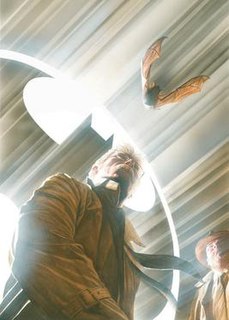
The Bat-Signal is a distress signal device appearing in American comic books published by DC Comics, as a means to summon the superhero, Batman. It is a specially modified searchlight with a stylized emblem of a bat affixed to the light, allowing it to project a large bat symbol onto cloudy night skies over Gotham City.
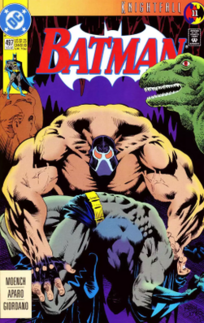
"Knightfall" is a 1993–1994 Batman story arc published by DC Comics. It consists of a trilogy of storylines that ran from 1993 to 1994, consisting of "Knightfall", "Knightquest", and "KnightsEnd".
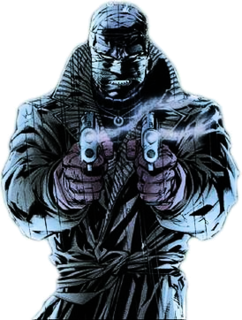
Hush is a fictional supervillain appearing in comic books published by DC Comics, commonly as an adversary of the superhero Batman. Hush first appeared in Batman #609 as part of the 12-issue storyline Batman: Hush. He was created by Jeph Loeb and Jim Lee. The character serves as a former friend-turn-criminal foil personality to the Dark Knight Detective.

Batsuit is the costume of the fictional superhero Batman, who appears in American comic books published by DC Comics. The suit has been depicted in various ways, and the stories themselves have described Batman as modifying the details of his costume from time to time. However, it usually consists of a grey body suit, the chest emblazoned with a stylized black bat either with or without a yellow ellipse around it, and blue-black accessories: a wide scalloped cape, gloves with a series of fin-like projections, boots, and a close-fitting cowl with ear-like projections to suggest a bat's head; and a utility belt containing a variety of gadgets.

The Batplane, Batwing, Batjet or Batgyro is the fictional aircraft for the DC Comics superhero Batman. The vehicle was introduced in "Batman Versus The Vampire, I", published in Detective Comics #31 in 1939, a story which saw Batman travel to continental Europe. In this issue it was referred to as the "Batgyro", and according to Les Daniels was "apparently inspired by Igor Sikorsky's first successful helicopter flight" of the same year. Initially based upon either an autogyro or helicopter, with a rotor, the Batgyro featured a bat motif at the front. The writers gave the Batgyro the ability to be "parked" in the air by Batman, hovering in such a way as to maintain its position and allow Batman to return.

"The Penguin Declines" is the 73rd episode of Batman, the conclusion of a three-part story in its second season on ABC. Its original telecast occurred on January 18, 1967 with a rerun June 21, 1967. It guest-starred Cesar Romero as Joker and Burgess Meredith as Penguin.

Batman and Robin is an American comic book ongoing series, created by Grant Morrison and featuring Batman and Robin. The debut of the series followed the events of "Batman R.I.P.", Final Crisis, and "Battle for the Cowl" in which the original Batman, Bruce Wayne, apparently died at the hands of DC Comics villain Darkseid and features the winner of the "Battle for the Cowl" as the new Batman. The conclusion of Battle for the Cowl shows Dick Grayson ascending to the role of Batman, while Damian Wayne becomes the new Robin.

Batman: Noël is an original 2011 graphic novel written and illustrated by Lee Bermejo, who previously did the artwork for Joker. It is based on Charles Dickens' classic 1843 novella A Christmas Carol and features characters from both Dickens and the Batman mythos. Like Joker, the story is narrated by one of the Joker's henchmen.

Lego Batman: The Movie – DC Super Heroes Unite is a direct-to-video computer-animated superhero action comedy film based on the video game Lego Batman 2: DC Super Heroes. Though the film has cutscenes from the video game, the gameplay is replaced by new scenes with the same actors. The plot revolves around Lex Luthor and the Joker teaming up to have the former be elected President, prompting Batman and Robin to join forces with the Justice League to stop them. The film was released on Blu-ray and DVD on 21 May 2013.

Batman: Arkham VR is a virtual reality adventure video game developed by Rocksteady Studios and published by Warner Bros. Interactive Entertainment for PlayStation 4 and Microsoft Windows. Based on the DC Comics superhero Batman, it is a part of the Batman: Arkham series and the first installment to use virtual reality headsets, allowing players to experience the game world from Batman's perspective. Arkham VR was released worldwide on October 11, 2016, for PlayStation 4 and on April 25, 2017, for Microsoft Windows for VR headsets.
Riddler was originally a comic book character and Batman's adversary, but has been substantially adapted from the comics into various forms of media, including feature films, television series, and video games. The Riddler has been voiced by John Glover in the DC animated universe, Robert Englund in The Batman, and Wally Wingert in the Batman: Arkham video game series. He has also been portrayed by Frank Gorshin and John Astin in the 1960s Batman television series, Jim Carrey in the 1995 film Batman Forever, Cory Michael Smith in the FOX television show Gotham, and Paul Dano in the upcoming 2021 film The Batman.
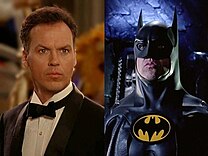
Bruce Wayne, better known by his superhero alias Batman, is a fictional character from Tim Burton's 1989 superhero film series, portrayed by Michael Keaton, Val Kilmer and George Clooney based on the DC Comics character Batman, created by Bob Kane and Bill Finger.
The fictional supervillain Penguin made his first appearance in Detective Comics #58 and was created by Bob Kane and Bill Finger, but has since been substantially adapted from the comics into various forms of media, including feature films, television series, and video games. For example, The Penguin has been voiced by Paul Williams and David Ogden Stiers in the DC animated universe, Tom Kenny in The Batman, and Nolan North in the Batman: Arkham video game series. His live-action portrayals include Burgess Meredith in the 1960s Batman television series and its spinoff film, Danny DeVito in Batman Returns, and Robin Lord Taylor in the television series Gotham.


















